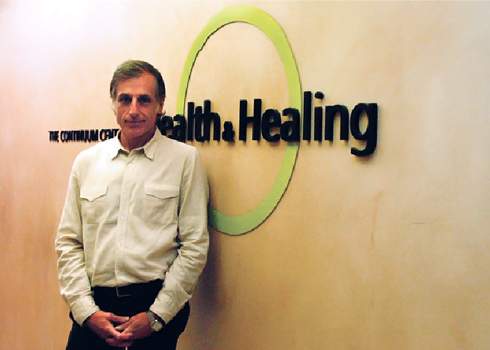When internist Dr. Martin Ehrlich is walking down the hall and realizes that he’s rushing, he tries to stay with that realization and take a deep breath; between patients, when he’s washing his hands, he consciously focuses on letting go of his last patient so that he can be present for the next one; and when he’s touching patients—when he’s listening to their heartbeat or asking them to breathe—he breathes with them. All of the above are common occurrences in Ehrlich’s routine, but instead of seeing them as mundane or unimportant, he uses them as reminders to be mindful.
Ehrlich was already practicing medicine when he was introduced to meditation by his wife, a Sufi, and though he doesn’t identify as a Sufi himself, he says that Sufi meditation has helped him in his interaction with patients. The meditation that’s practiced in the Sufi tradition involves focusing on love—on taking everything into the heart. With the aid of this meditation, says Dr. Ehrlich, “I could connect on an emotional level with people more than I’d ever done before. It gave me a better sense of where people were at.” But, for Dr. Ehrlich, Mindfulness Based Stress Reduction (MBSR) has also had a profound effect.
Ehrlich practices in New York at the Beth Israel Continuum Center for Health and Healing, one of the largest integrative medicine centers in the United States, and for years before taking an MBSR course himself, he was recommending it to patients. He says, “These were people who were dealing with all kinds of problems—chronic stress, chronic pain, depression, insomnia, irritable bowels—and pretty much unanimously I would get incredible feedback.” Patients would come back from an MBSR program saying, “It changed my life.”
When Ehrlich became the medical director of the Continuum Center, he invited an MBSR teacher to begin leading programs there, and finally Ehrlich himself took the course. Since then, he too has noticed enormous changes in his life, principally in how he deals with stress.
“I was known for not having the gentlest temper and I didn’t like that about myself,” he says. “I would become irritable and always be sorry afterwards. It would happen with coworkers and family members, and it would happen occasionally with patients. I’m still far from perfect—I have lapses. But I’m aware of them almost as they’re happening, so I’m able to not be as reactive.”
In the past, Dr. Ehrlich found that he didn’t necessarily take his irritation out on his patients directly, but he would lose connection with them—lose compassion. “Sometimes, as a busy doctor, you get concerned with the clock,” he says, especially when patients take up more than their allotted time. In this situation, Ehrlich often used to get nervous and cut his attention off, rushing the patient. Now, he’s more aware of his thoughts and emotions and can verbalize his concerns, saying something like: We’ve run out of time. I know we haven’t finished everything, so let’s meet again soon. “I’m more in touch with the needs, or unmet needs, of the patient,” he says.
Dr. Ehrlich encourages his patients to be aware as well. “To the extent that I can, I teach them to pay attention to their own symptoms and their own mindset, and get them to look at their thoughts, bodily sensations, and emotions as temporary things that come and go. It’s an amazing process to do this within myself, and also do it together with patients.”
This story is one of four inspiring stories, written by Andrea Miller, of how real people are integrating mindfulness into their lives. For more, read about Toni Bernard, Alex Tower Ewers & Patrick Ewers and Mindy Winter.






